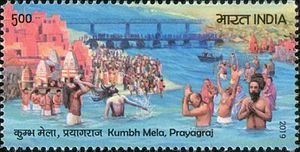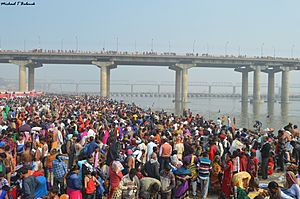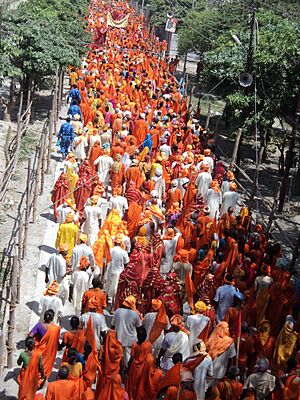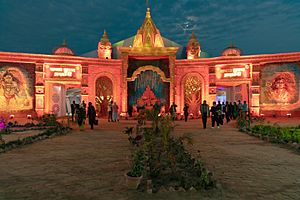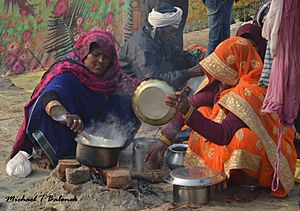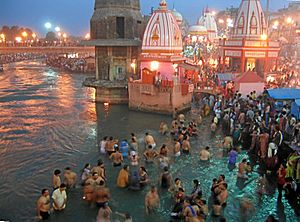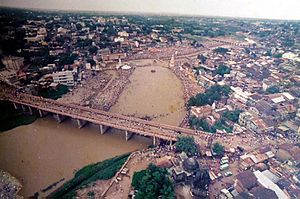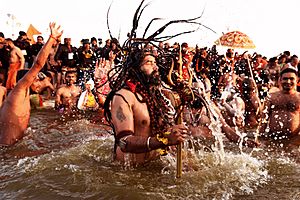Kumbh Mela facts for kids
Quick facts for kids Kumbh Mela |
|
|---|---|
|
UNESCO Intangible Cultural Heritage
|
|
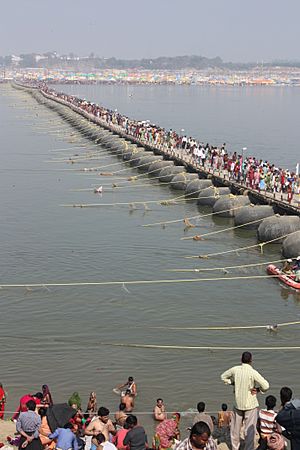
Prayag Kumbh Mela in 2013
|
|
| Country | India |
| Domains | Religious pilgrimage, rituals, social practices and festive events |
| Criteria | None |
| Reference | 01258 |
| Region | Asia and the Pacific |
| Inscription history | |
| Inscription | 2017 (12th session) |
| List | Representative |
 Held alternately among Prayagraj, Haridwar, Nashik and Ujjain every three years. |
|
The Kumbh Mela is a very important Hindu festival and pilgrimage. It happens about every 12 years at four special river places in India: Prayagraj (where the Ganges, Yamuna, and mythical Sarasvati rivers meet), Haridwar (Ganges), Nashik (Godavari), and Ujjain (Shipra). People come to bathe in the holy rivers. They believe this bath helps them wash away past mistakes and cleanses them.
The festival is also a huge gathering. It includes big fairs, educational talks, and entertainment. Many monks and spiritual leaders also gather here. The timing of the festival depends on the positions of Jupiter, the sun, and the moon in the Hindu calendar. The Kumbh Mela is known as one of the largest peaceful gatherings in the world. Millions of people attend, making it a truly amazing event. It is even recognized by UNESCO as an important cultural heritage.
Contents
What does "Kumbh Mela" mean?
The word Kumbha means "pitcher," "jar," or "pot" in Sanskrit. This word is found in very old Hindu texts. It often refers to a pot holding water or the special "nectar of immortality." In astrology, it also means the zodiac sign of Aquarius.
The word mela means "to unite," "to join," or "an assembly." It is used for fairs and community celebrations. So, Kumbh Mela means a "gathering" around the idea of "water or nectar of immortality."
The Story of the Nectar Pot
Many Hindus believe the Kumbh Mela started a very long time ago. It is linked to a Hindu story called Samudra manthan, which means "churning of the ocean." In this legend, gods and demons churned the ocean to create a pot of amrita (nectar of immortality). They fought over this pot, the "kumbh," to become immortal.
Later versions of the story say that drops of this nectar spilled at four places. These four places are believed to be where the Kumbh Melas are held today. However, older texts about the Samudra manthan story do not mention this spilling or link it to a festival.
A Look at the History of the Mela
The earliest mentions of bathing pilgrimages at Prayag are found in ancient texts. For example, the Mahabharata talks about bathing at Prayag to make up for past mistakes. It says that bathing there can help someone become pure and reach heaven.
The Chinese traveler Xuanzang visited India in the 7th century. He wrote about a Hindu bathing ritual at the meeting point of rivers in Prayag. Some scholars believe this is the first historical record of the Kumbh Mela, happening around 644 CE.
Later Hindu texts from the 1st millennium CE also describe Prayag as a busy place. It was filled with pilgrims, priests, and vendors. These texts were like guidebooks for pilgrims visiting the holy rivers.
How the Melas Changed Over Time
Old texts don't use the exact phrase "Kumbh Mela." But they clearly describe large bathing festivals. These festivals happened every year or every 12 years, based on the planet Jupiter's cycle.
Warrior monks, called akharas, played a big role in these gatherings. They helped organize the festivals. They also provided security and managed trade. The Kumbh Melas were important places for these monks to recruit new members and trade goods.
The Haridwar Kumbh Mela seems to be the original one. It is held when the astrological sign "Kumbha" (Aquarius) is present. Texts from the 17th and 18th centuries mention "Kumbha Mela" specifically for Haridwar. They also mention similar fairs in Prayag and Nashik, but without calling them "Kumbh."
The names "Maha Kumbh" and "Ardh Kumbh" for the festivals at Prayag, Nashik, and Ujjain are more recent. They became popular in the 19th century. The British colonial government also started to get involved. They wanted to control the monks and the money from taxes and trade at these festivals.

Warrior Monks and Their Role
A key part of the Kumbh Mela is the presence of sadhus (monks). By the 18th century, many of these monks had formed groups called akharas. These were like monastic armies. They helped manage the melas, settled arguments, and collected taxes.
These akharas were also a big attraction for regular Hindus. People came to see them and get spiritual advice. The Kumbh Melas were important for these groups to find new members and to trade.
In the 17th century, these akharas sometimes fought each other over who would bathe first or at the best time. Records from the British era mention violent clashes. For example, in 1760, hundreds died in a fight between different groups of monks at the Haridwar Kumbh Mela.
Because of these fights, the British East India Company stepped in. They started to organize the camps, trading areas, and bathing order for each akhara. After India became independent in 1947, the state governments took over this role. They now provide all the necessary facilities for the Kumbh Mela.
Why is the Kumbh Mela Important?
The Kumbh Melas have been very important to Hindus for centuries. They are more than just religious events. Historically, they were also big trade fairs. New monks were initiated, and there were prayers, community singing, and spiritual discussions.
During the British colonial period, officials saw the festival as a way to collect a lot of money through a "pilgrim tax." This tax was so high that fewer people attended. However, in 1938, the tax was removed, and many more people returned to the pilgrimage.
Old reports describe the fairs as very lively. There were horse traders, Arabs, and Persians. Merchants sold food, clothes, and toys. Thousands of pilgrims came, dressed in colorful clothes, some shouting religious phrases. At night, the river banks lit up with oil lamps and fireworks.
The Mela and India's Freedom Fight
The Kumbh Mela also played a role in India's fight for independence. It was a place where many people and politicians gathered. In 1906, a religious group met at the Prayag Kumbh Mela. They decided to start the Banaras Hindu University. The Kumbh Melas continued to be important meeting places for the independence movement until 1947.
Growing Numbers of Visitors
The number of people attending the Kumbh Mela has grown a lot. In the early 1800s, about 2 to 2.5 million pilgrims attended. During times of famine and disease, the numbers dropped.
After India became independent, attendance increased sharply. In 1954, over 5 million people attended. By 1989, about 15 million people came. In 2001, officials estimated 70 million people attended the festival. Over 40 million were there on the busiest day.
In 2013, 120 million pilgrims attended the Kumbh Mela at Prayagraj. The Maha Kumbh at Prayagraj is the largest in the world. The preparations for it are huge. For the 2019 Ardh Kumbh, a temporary city was built. It had thousands of toilets, different types of tents, and special trains. There was even smart video security and a mobile app to help visitors.
The Kumbh Mela is truly seen as the "world's largest religious gathering." People who attend feel a sense of "brotherhood and love." Millions gather peacefully, sharing their heritage.
When and Where Does it Happen?
Types of Kumbh Melas
There are different types of Kumbh Melas:
- The Purna Kumbh Mela (or "full Kumbh") happens every 12 years at one of the four sites.
- The Ardh Kumbh Mela ("half Kumbh") happens about every 6 years. This is between two Purna Kumbh Melas at Prayagraj and Haridwar.
- The Maha Kumbh is the biggest one. It happens every 12 Purna Kumbh Melas, which is about every 144 years.
In 2019, the Ardh Kumbh Mela at Prayagraj was simply called "Kumbh Mela." The 12-year Kumbh Mela is now called "Maha Kumbh Mela."
Locations of the Melas
Four main sites are recognized for the Kumbh Melas:
Other places sometimes have similar bathing festivals. These include Kurukshetra and Sonipat.
When are the Dates?
The exact dates for each Mela are calculated using the positions of Jupiter, the Sun, and the Moon in the zodiac. The cycle repeats about every 12 years. Sometimes, due to Jupiter's orbit, a Mela might happen after 11 years.
| Place | River | Zodiac | Season, months | First bathing date | Second date | Third date |
|---|---|---|---|---|---|---|
| Haridwar | Ganga | Jupiter in Aquarius, Sun in Aries | Spring, Chaitra (January–April) | Shivaratri | Chaitra Amavasya (new moon) | Mesh Sankranti |
| Prayagraj | Ganga and Yamuna junction | Jupiter in Aries, Sun and Moon in Capricorn; or Jupiter in Taurus, Sun in Capricorn | Winter, Magha (January–February) | Makar Sankranti | Magh Amavasya | Vasant Panchami |
| Trimbak-Nashik | Godavari | Jupiter in Leo; or Jupiter, Sun and Moon enters in Cancer on lunar conjunction | Summer, Bhadrapada (August–September) | Simha sankranti | Bhadrapada Amavasya | Devotthayan Ekadashi |
| Ujjain | Shipra | Jupiter in Leo and Sun in Aries; or Jupiter, Sun, and Moon in Libra on Kartik Amavasya | Spring, Vaisakha (April–May) | Chaitra Purnima | Chaitra Amavasya | Vaisakh Purnima |
Managing the Huge Festival
Managing the Kumbh Mela is a very big and difficult job. Tens of millions of pilgrims visit. Providing safe places to stay, food, water, sanitation, and medical care needs a lot of planning. Also, managing crowds, preventing disasters, and helping lost people is crucial.
At Prayag, the festival area is often underwater during monsoon season. This means workers have only about two and a half months to build all the temporary facilities. This makes the task even harder.
In 2013, the Indian government and volunteers set up many camps. They provided first aid, ambulances, and clean water. They also managed food distribution and fire services. Studies found that the Mela was well-managed, safe, and convenient for pilgrims.
Important Rituals at the Mela
The main ritual at the Kumbh Mela is bathing in the river waters. People offer prayers as they dip into the water. On the most important bathing day, called amavasya, Hindu pilgrims wait for the thirteen sadhu akharas (monk groups) to bathe first.
This special event is called shahi snan or rajyogi snan. It involves a grand procession with banners, flags, elephants, horses, and musicians. The monks, some covered in ashes, march along. People gather to watch this procession and cheer for the monks. After the monks have bathed, everyone else can take their dip.
Pilgrims might also shave their heads and offer flowers or milk. They recite hymns and pray for their ancestors. Some perform a yajna (fire ritual) led by a priest. After bathing, many visit nearby Hindu temples.
People believe that visiting the Kumbh Mela and bathing in these holy rivers can help them achieve moksha. This means liberation from the cycle of rebirths. The pilgrimage is also seen as a way to repent for mistakes and purify oneself.
Feasts, Fun, and Discussions
Some pilgrims walk long distances, even barefoot, as part of their religious practice. Most stay for a day or two. But some stay for the entire month of Magh. These pilgrims, called kalpavasis, live a simple life. They attend spiritual talks, fast, and pray.
The festival site is strictly vegetarian. Violence against animals is not allowed. Many pilgrims fast or eat simple meals. But there are also big community feasts. Volunteers prepare and serve meals to thousands of people, especially monks and the poor. Families and companies often sponsor these "food charity" events.
Other activities at the mela include religious discussions, devotional singing, and debates about religious ideas. There are also many cultural shows. These include Indian arts, laser light shows, classical dance, and music. Visitors can also take boat rides and visit historic sites. They can even visit the monk camps to watch yoga experts and listen to spiritual talks.
Darshan: The Act of Seeing
Darshan, or viewing, is a very important part of the Kumbh Mela. People come to see and experience both the religious and everyday parts of the event. The sadhus (Hindu holy men) are a major group at the Mela. They show how life is temporary through their yoga practices.
Sadhus come to the Kumbh Mela to be available to the public. This allows people to meet them and take "darshan." They can "seek instruction or advice in their spiritual lives." Darshan is about a visual exchange. It's when a worshiper interacts with a religious figure and can "drink" divine power by seeing them. The camps at the Kumbh Mela are set up so people can easily access the sadhus.
Kumbh Mela in Culture
The Kumbh Mela has been the subject of many documentaries. These include Kings with Straw Mats (1998) and Short Cut to Nirvana: Kumbh Mela (2004). National Geographic has also filmed and broadcast documentaries about the Mela, like Inside Nirvana (2007) and Inside the Mahakumbh (2013).
The Mela is often covered by news media from India and other countries. In 2010, an American morning show called it "The Largest Pilgrimage on Earth." The BBC also reported on it as the "greatest show on earth."
In Hindi movies, a common story used to be about young siblings getting separated at the Kumbh Mela. There have also been other films about the Mela, like the Bengali film Amrita Kumbher Sandhane (1982).
See also
 In Spanish: Kumbhamela para niños
In Spanish: Kumbhamela para niños
- Barahakshetra – A smaller Kumbh Mela in Nepal
- Mahamaham – the Tamil Kumbh Mela
- Pushkaram – river festivals in South India
- Pushkar Fair – a springtime fair in Rajasthan
- List of largest gatherings in history


